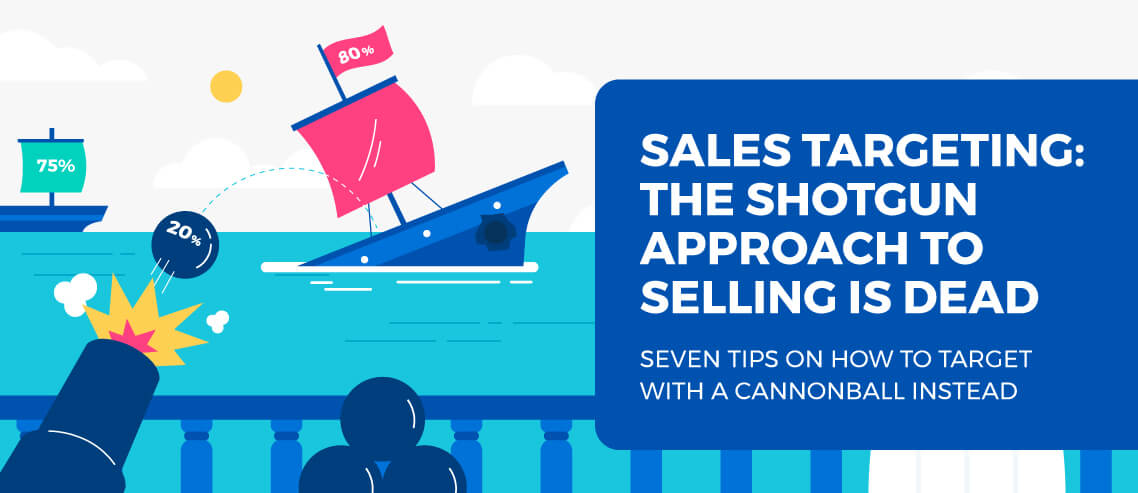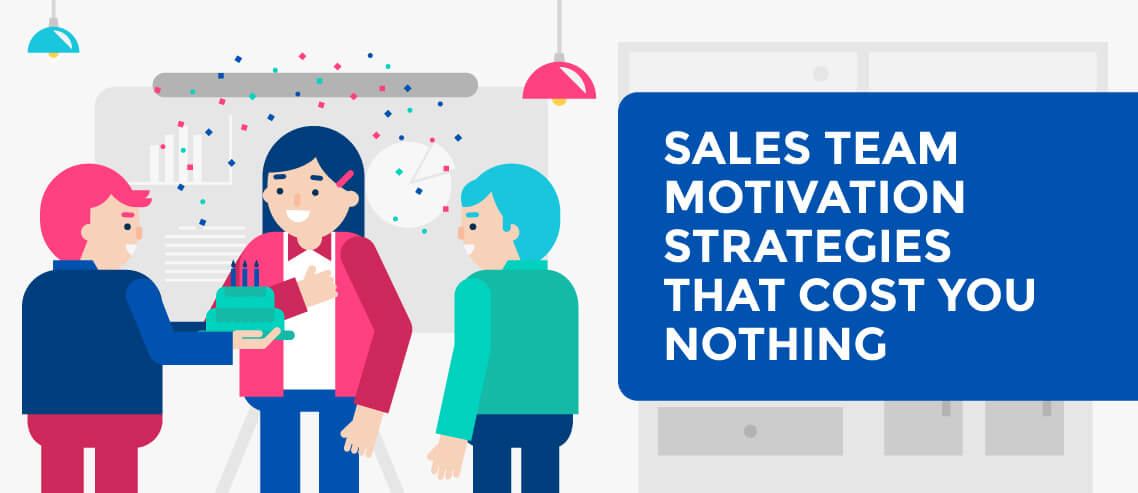Sales Targeting: The Shotgun Approach to Selling is Dead

Contents
Here is a fact to wrap your head around…
According to Salesforce, 57% of sales reps fail to meet their quota these days.

The economy is booming, unemployment is at an all-time low, yet six out of ten salespeople are dying on the vine. Where is the disconnect?
Some argue this has always been the case, while others place the accountability on their companies for setting the bar too high.
Allow me to suggest a third possibility.
Maybe… just maybe… ALL the business won is coming from the same group of sellers. That’s right, I’m hypothesizing that the same four out of ten reps are winning all the new great customer bids.
Before you say that’s not possible, consider the Pareto Principle: Eighty percent of output typically comes from the top 20 percent of actionable input. Why then would it be hard to conceive that our customers are choosing to buy from a select few?
If that’s the case, it’s important to know what sets the successful few — those 20% — apart.
Here’s what I’m seeing…
The business world is rapidly and exponentially changing around us, and too few of us are keeping up. Many salespeople still look like something out of the Wolf of Wall Street. They carry paper planners and hit up the town like some sort of pub crawl, shaking hands and kissing babies.
Strategy? What’s that? It’s all about volume baby! Fill your funnel! Nothing replaces good old-fashioned hard work and a long line of prospects, right?
Wrong! Sales targeting must be precise. The shotgun approach to selling is dead.
No longer can we simply prepare and pitch our way to success. Instead, we must identify the select few target customers, those with the most promise, and go all in. We should be targeting with something more akin to a cannon, not a shotgun.
Strategy, much like the Battleship games of our youth, is paramount to success.
Let us then look at seven tips on how to take a cannonball approach to sales targeting.
How to Define Your Target & Generate Impact (7 Steps)
Step 1. Map Your Territory

Think about the 80-20 Rule: 80% of output will come from the top 20% of input. Clearly, less is more, especially if you can create deep awareness and focus.
Find the customers that are likely to benefit the most from what you have to offer and look for value through the eyes of the receiver.
Questions to Ask Yourself:
- What are the top 20% of targets that drive 80% of sales?
- What 20% of your actions drive 80% of results?
- Which prospects or customers are most likely to be receptive to what I have to offer?
- Which are willing and able to make a change?
Step 2. Plot Your Targets
Bucketing your business is important, whether you’re new to a territory or have years of experience with your customer base — and it’s key to sales targeting.
Bucketing your business is about categorizing your customers into segments or groups. Your buckets may be based on the types of products they buy, the recency of their last purchase, their industry or size of business, or any other grouping that makes sense.
The goal of mapping is to understand where you’re getting your business, who from, and what opportunities or threats may exist. It’s akin to a well-diversified stock portfolio.
It’s an exercise that should be done regularly and consistently, so you have benchmarks for what’s working and what’s not, and who you should be targeting.
How to Bucket Your Business
Start by making a list of all your customers. Then do some analysis to understand what percent of your business comes from each.
Step 1: The first part of this exercise is to decide which group of customers provide consistent and sustainable revenue. Call this group your “why” bucket because chances are you’re already aligned on value.
Step 2: Next, identify the customers who seemingly purchase with some regularity but are still inconsistent and ripe with potential. This is your “how” group.
Step 3: Lastly, take the remaining customers and label them your “what” group. Your what group has trialed or ordered a few times, but they are either early in development or you’ve yet to gain their trust or commitment.
RELATED: How To Automate Prospect Research Without Sacrificing Lead Quality
Step 3. Develop a Targeting Strategy

It’s easy to prioritize one target group over another based on your own preferences. Here, you’ll use a tool to remove emotion from your decisions.
Step 1: Take your customer base and add them to a spreadsheet. Now, stack-rank them on revenue generation from highest to lowest.
Step 2: On a separate tab or worksheet, rank them on perceived future revenue potential. Make sure you pick some targets and prospects from each of your buckets.
Pick a couple of long term opportunities with sizeable potential, several steady-eddy or low-risk targets, and a good breadth of additional prospects that are quick hits. Use your buckets to identify where these are coming from.
Step 3: Finally, on a third sheet, come up with a list of variables that you believe will increase or decrease the customers’ ability to take action or implement change.
For each of these factors, assign an equally weighted value. For instance, let’s say the factors are “red tape,” “readiness,” “purchasing power,” and “internal influence.”
For each variable use a value from 1 to 10 for each customer (1 meaning they are high in that variable and 10 meaning they are low). Then run a sum function and stack-rank your third sheet from lowest value to highest.
Step 4: Write a formula such that X=sheet1 rank times .25 + sheet2 rank times .25 + sheet3 rank times .5.
Sound too complicated? I’ve got good news for you. I’ve done most of the work for you. The formulas and spreadsheets depicting this example, along with a free tool you can use for your own customer base, can be found at The Pirate’s Guide under targeting tools.
Step 4. Plan Your Approach
Now it’s time to create your pre-call plan.
The topic of “why” is discussed a lot of late. However, few books and methods tell you how to uncover the “why.” As a result, even when our plan originates with the “why,” we work off of assumptions.
Your planning must start with an understanding of where and what the value is in the eyes of the receiver.
Create a List of Questions to Ask the Prospect:
- Why is having the right partner or vendor important to this business segment?
- Why have you made this a priority?
- Why did you choose your current vendor or product?
- Why would you consider switching in the future?
- Why would you be concerned to make a switch?
RELATED: 15 Sales Qualifying Questions (And Why They Work)
Step 5. Know When to Use a Cannonball to Sink a Ship

In order to sink a big ship and close a big deal, you must avoid fear and go all in. You need to know when a big deal is in your sights — and go get it.
Too often we allow distractions or timing to get in the way of success. When you have a big target in your sights, adjust your calendar and schedule time to prepare, so you can ensure the win.
Step 6. Generate Big Impact
Often the best part of landing a big target is the story you can then tell other customers in the same industry. Nothing sells better than a case study from a trusted source from within.
How can you parlay the deal you just closed to win business from other similar clientele? It’s hard to land a big customer by sharing examples from smaller companies playing a smaller game.
Once you’ve won a new deal and the customer is satisfied, track every data point you can that points to success in the partnership. Then build a case study you can use in similar opportunities, where your customer’s success will resonate.
RELATED: How to Turn Your Customers Into Your Salespeople
Step 7. Embrace Crashes and Misses
Be prepared: the road to success is paved with failures. The key is to quickly learn from mistakes. Look at failure as future opportunity. Don’t spend too much time making excuses or benchmarking the failure to others.
Sales Targeting Success
So, what are you to take away from all this?
Our customers are changing and expect more from us. We can’t ignore (or fight) change. Just as the middle class has seen a decline in recent years, the “average” sales rep is currently taking a sizeable hit to their pocketbook.
With things changing so quickly, it’s critical that you clearly define your target.
Start looking at your business through the eyes of your customers.
Approach sales targeting from a different perspective: Develop a strategy instead of a plan — and when you have a big customer in your sights, use a cannonball!
If you want to learn more sales targeting techniques, tips, and tricks, check out the book that stemmed from the five-year project, The Pirate’s Guide to Sales: A Seller’s Guide for Getting from Why to Buy. It’s available on Amazon, Kindle, and will soon be appearing on Audible.





